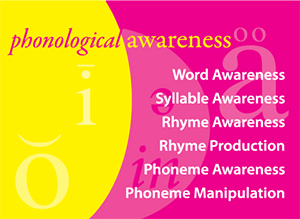Students with strong phonological awareness are likely to become good readers, but students with weak phonological skills will likely become poor readers (Blachman, 2000). It is estimated that the vast majority—more than 90 percent—of students with significant reading problems have a core deficit in their ability to process phonological information (Blachman, 1995).
 Phonological awareness is an umbrella term that includes six developmental levels: word awareness, rhyme awareness, syllable awareness, rhyme production, phoneme awareness, and phoneme manipulation. Our Phonological Awareness Skills table shows how specific phonological awareness skills fall into the six developmental levels. The table provides an example for each skill. We hope you will download, use, and share this free resource!
Phonological awareness is an umbrella term that includes six developmental levels: word awareness, rhyme awareness, syllable awareness, rhyme production, phoneme awareness, and phoneme manipulation. Our Phonological Awareness Skills table shows how specific phonological awareness skills fall into the six developmental levels. The table provides an example for each skill. We hope you will download, use, and share this free resource!
Notice the arrow across the top of the table. The levels become more complex as students progress from word awareness to phoneme manipulation. Then, notice the arrow along the left-hand side. Students progress within each level, learning increasingly complex skills.
Phoneme awareness is the understanding that spoken language words can be broken into individual phonemes—the smallest unit of spoken language. Manipulating individual phonemes to make new words is the most challenging level of the phonological awareness skills. As students begin to transition to phonics, they learn the relationship between a phoneme (sound) and a grapheme (the letter or combination of letters that represent the sound in written language).
From research, we know that segmenting words into phonemes and blending phonemes into words contributes more to learning to read and spell well than any of the other activities under the phonological awareness umbrella (National Reading Panel, 2000; Snider, 1995). And the ability to manipulate phonemes also has very strong predictive correlations to reading success. (Lundberg, Olofsson, and Wall, 1980; Mann, 1984; Rosner and Simon, 1971.) So, as we plan phonological awareness instruction, our goal is to systematically move students as quickly as possible toward blending and segmenting at the phoneme level.
 Free Resource: Phonological Awareness Skills table
Free Resource: Phonological Awareness Skills table
 Learn more about phonological awareness
Learn more about phonological awareness
Programs That Develop Phoneme Awareness
Funēmics: If you are looking for a phonological awareness program for small groups of pre-readers or kindergarten students or for a phoneme awareness intervention for struggling readers in grades 1 and 2, check out Funēmics. Funēmics is grapheme-free and can be used with any reading curriculum.
Read Naturally GATE: If you are looking for a beginning reading intervention for small groups that includes phoneme awareness as well as the other components of reading instruction, check out Read Naturally GATE.
References & Further Reading:
Blachman, B. A. (2000). Phonological awareness. In M. L. Kamil, P. B. Rosenthal, P. D. Pearson, and R. Barr (eds.), Handbook of Reading Research, 3, pp. 483-502. Mahwah, NJ: Erlbaum.
Blachman, B. A. (1995). Identifying the core linguistic deficits and the critical conditions for early intervention with children with reading disabilities. Paper presented at the annual meeting of the Learning Disabilities Association, Orlando, FL, March 1995.
Lane, H. B., and P. C. Pullen. (2004). A sound beginning: Phonological awareness assessment and instruction. Boston: Allyn & Bacon.
Lundberg, I., Olofsson, A., and Wall, S. (1980). Reading and spelling skills in the first two years predicted from phonemic awareness skills in kindergarten. Scandinavian Journal of Psychology, 21, pp. 159-73.
Mann, V.A. (1984). Longitudinal prediction and prevention of reading difficulty. Annals of Dyslexia, 34, pp. 117-137.
National Reading Panel. (2000). Teaching children to read: An evidence-based assessment of the scientific research literature on reading and its implications for reading instruction. Washington, DC: National Institute of Child Health and Human Development.
Rosner and Simon, D. P. (1971). The auditory analysis test: An initial report. Journal of Learning Disabilities, 4, pp. 384-92.
Snider, V. A. (1995). A primer on phonemic awareness: What it is, why it’s important, and how to teach it. School Psychology Review, 24(3), pp. 443-456.
 Share your student’s success story—nominate him or her for our Star of the Month award. Win a Barnes & Noble gift card for the student and a Read Naturally gift certificate for your class!
Share your student’s success story—nominate him or her for our Star of the Month award. Win a Barnes & Noble gift card for the student and a Read Naturally gift certificate for your class!
Post a New Comment